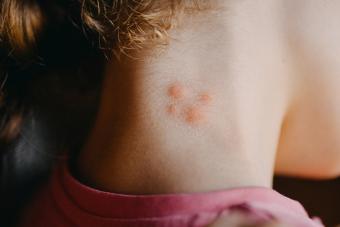
The red strep rash of scarlet fever is the hallmark sign of the disease. Scarlet fever occurs in a small percentage of children, most commonly between the ages of 5 and 12, who get a strep throat infection (streptococcal pharyngitis), and less often, a strep skin infection. Because scarlet fever is usually associated with a strep throat, this scarlet strep rash is typically accompanied by the symptoms and signs of strep throat.
Strep Rash
The distinctive strep rash of scarlet fever is caused by a toxin produced by the strep bacteria that affects the skin. Some people refer to the condition as strep rash, while others call it scarlet fever rash.
The rash can be identified by the following features:
- Looks like multiple fine, red, slightly raised bumps
- Feels rough like sandpaper
- Looks like sunburn
- Looks brighter red in skin creases, such as the neck, elbow, knees, armpits and groin (Pastia's lines)
- The redness turns white when pressed
- The face is red with often a pale ring around the mouth.
The strep rash usually:
- Starts 1-2 days after a fever occurs, but can begin up to a week later
- First appears over the neck, chest and abdomen, and then spreads all over the body
- Resolves in 7 days
After the strep rash resolves, the skin can peel, especially on the tips of fingers and toes, the palms, and the groin.
Cause
Scarlet fever and strep throat are caused by a bacteria called group A beta-hemolytic streptococcus (Group A beta strep). Scarlet fever can occur 1 to 7 days after exposure to the bacteria, with an average of 3 days.
Group A beta strep:

- Is common in the throat, nose, and skin
- Can cause other skin diseases such as impetigo
- Is highly contagious during an infection
- Can be spread from infected airborne droplets from the mouth or nose through coughing or sneezing.
- Can also be spread from touching infected sores and then the nose or mouth
- Less commonly, it can also be spread from sharing utensils or towels
Symptoms of Scarlet Fever
In addition to the scarlet rash, the symptoms of scarlet fever are those commonly seen with strep throat alone:
- Severe sore throat
- A swollen throat
- A swollen tongue
- Difficulty swallowing
- High fever
Secondary symptoms include:
- Body aches
- Headache
- Listlessness
- Nausea
- Vomiting
If sore throat is accompanied by coughing, sneezing, or a runny, stuffy nose usually the cause is a virus and not group A beta-strep.
Clinical Signs
When a child is taken to the doctor with a red rash accompanied by fever and a sore throat, an examination will be required to determine if he or she may have strep throat or scarlet fever. The following signs can help to make the diagnosis:
- Temperature of greater than 101°F (38.3°C)
- Red, swollen throat
- Swollen tonsils
- White or yellow spots in the throat or on the tonsils
- A swollen tongue with red bumps; the so-called 'strawberry tongue'
- Swollen or tender lymph glands in the neck
Diagnosis
To confirm the diagnosis of strep throat or scarlet fever a doctor can do one or two lab tests:
- A rapid test from a throat swab, which can be done in 10 to 15 minutes in the office
- A throat swab culture, which must be sent to a lab and will be ready in 1 to 2 days
The doctor usually starts with the rapid test and if it is positive he can prescribe treatment then.
If the rapid test is negative, a throat culture is sent to the lab to be sure. The doctor can decide whether or not to begin antibiotic treatment before the lab results come back based on:
- The severity of the symptoms
- His or her degree of certainty that the child has a diagnosis of strep throat or scarlet fever
Treatment of Strep Throat and Scarlet Fever
Scarlet fever and Strep throat are curable with oral antibiotics, usually a penicillin such as Amoxicillin. Antibiotics shorten the time a child is contagious and most patients will not be contagious after 24 hours of antibiotics.
Other treatments for relief of symptoms include:
- Rest
- Fluids
- Soothing throat lozenges
- Cool baths
- Humidifier or vaporizer to help throat symptoms and breathing
- Ibuprofen (Motrin, Advil) or Acetaminophen (Tylenol) to relieve body aches and fever
Anyone less than 20 years old should not be given aspirin because of the risk of Reyes' syndrome, a potentially fatal liver and brain disease.
Complications of Strep Infection
If strep throat or scarlet fever is left untreated the following can occur:
- Abscess formation in the tonsils or around the tonsils (peritonsillar)
- Middle ear infection
- Sinusitis
- Pneumonia
Less common but serious complications include:
- Rheumatic fever, an autoimmune process primarily affecting the heart and joints and can lead to rheumatic heart disease from damaged heart valves and arthritis
- Glomerulonephritis, an autoimmune inflammation of the kidneys that can lead to kidney failure
- Pediatric autoimmune neuropsychiatric disorders associated with streptococcal infections (PANDAS), a rare condition where symptoms of certain problems the child has, such as OCD and Tourette syndrome, can worsen
Prevention
- Avoid contact with others who are infected
- Wash hands
- Avoid sharing personal items, such as towels and utensils
Curable With Treatment
Scarlet fever with its accompanying distinctive scarlet strep rash is highly curable with early treatment. If your child develops a rash with sore throat and a high fever, be certain to see a doctor for treatment with antibiotics to prevent serious complications.







